
I don't know where the artificial stops and the real starts.
| |
– Andy Warhol, as quoted by Gretchen Berg in “Andy Warhol: My True Story,” 1966 in I’ll Be Your Mirror: The Selected Andy Warhol Interviews: 1962-1987, ed. Kenneth Goldsmith (New York: Carrol & Graf Publishers, 2004), 93.
|
Overview
When my significant other and I decided to marry, as his wedding present to me, he let me turn our wedding into art.
I'm interested in, among other things, the blending of the real and the artificial. In this project, the bond of a real marriage between two individuals serves as a metaphor to explore larger historical, sociological, psychological, epistemological, and metaphysical contexts – including the bond that, for better or worse, has in some sense always existed among all of humanity but that now, via the internet, is becoming much more thickly and quickly interconnected on the virtual plane.
The project involves three layers of video. Versions of the first two videos were projected at the initial wedding/performance/screenings, and a third is being edited from footage shot during the event.
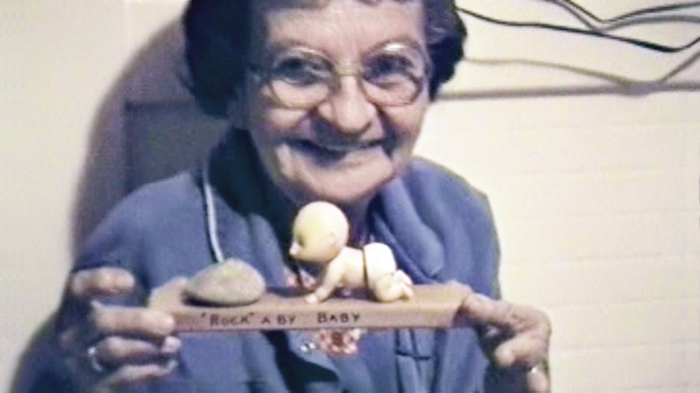
The event took place in a dark parking lot, near deteriorated buildings and an incomplete bridge, in a not-yet gentrified part of Dallas, Texas. Guests attending the wedding/performance/screenings were requested to wear white or pale colors and were also invited to wear brides' dresses; and as guests arrived, they were also offered white veils to wear.
Guests were then guided to a defined area, where they became a virtual screen. (The drawings below are not to scale.)
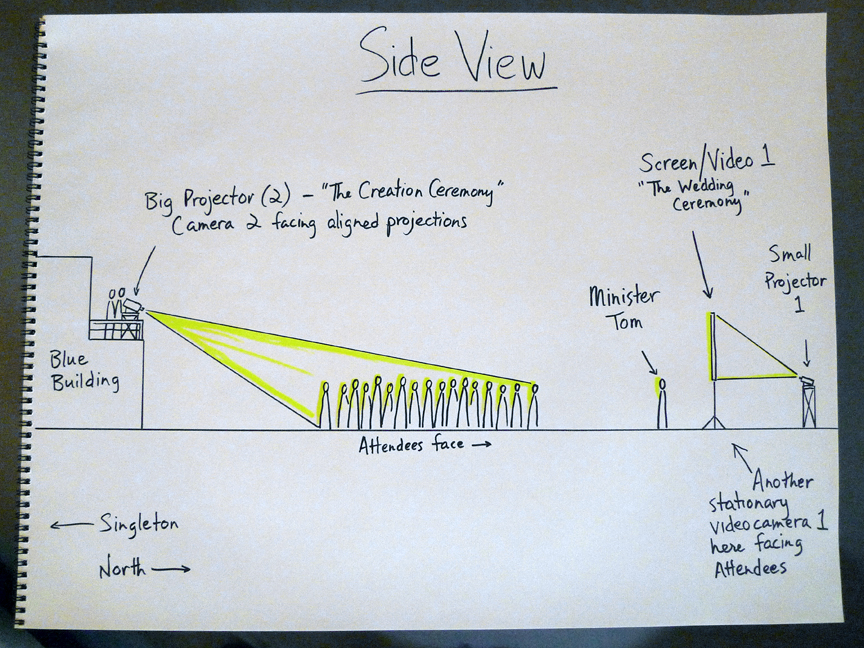
The first video, Wedding Ceremony, was designed to be the actual marriage ceremony and was projected onto a screen just above and behind the minister, where it could be viewed by the guests. The ceremony text was incorporated into this video, and the book from which the minister read it was a powerbook laptop, which also served as the player for the projection of this video.
The second video, Creation Ceremony, was projected from a balcony above and behind the guests onto their backs.
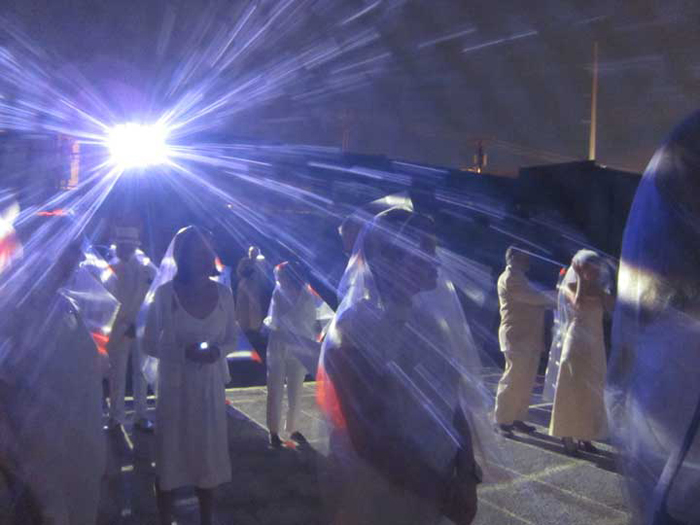
A stationary video camera was also positioned on the balcony near the projector and aligned as closely as possible with it, in order to record the event from the same vantage point. From this point of view, the video projected onto the virtual screen formed by guest-participants' backs appeared to have roughly the same aspect ratio as if screened in the normal way.
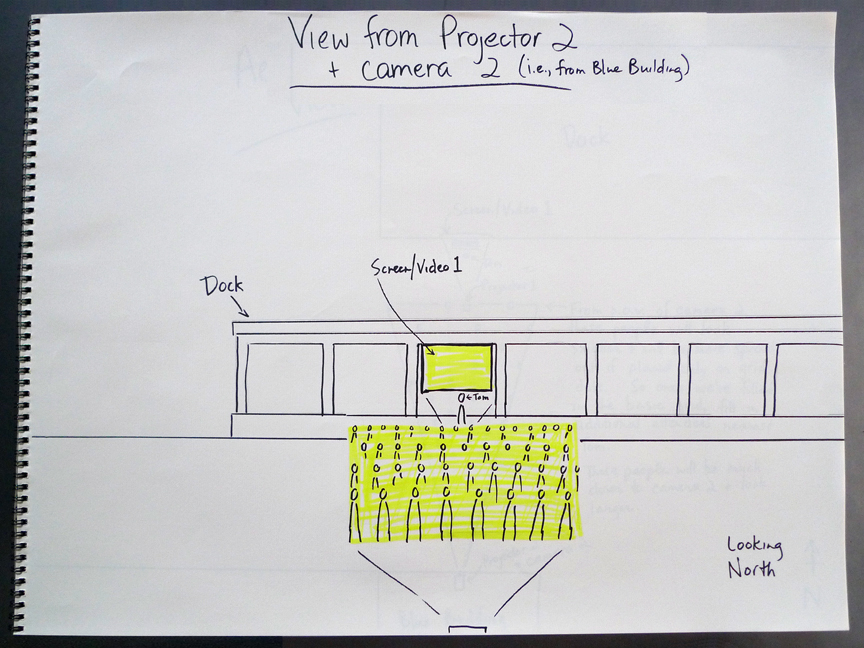
In addition to the camera on the balcony, a stationary video camera was positioned facing the participant-guests, and there were also four roving, hand-held cameras. The third video, Alignment Ceremony, is currently being edited from the footage shot during the event.
Participatory Aspects
This phase of the project involved relational or participatory aspects. First, in lieu of traditional wedding presents, people were invited to participate by helping in various ways, such as creating props and set decor, guiding guests at the event, operating or lending cameras, projectors, and other equipment, providing entertainment, decorations or refreshments for the reception, or contributing toward the hard costs of the project. Approximately 100 people participated in the production, most contributing their talents, time, and efforts rather than cash (see the Programme for credits).
Second, guests participated in the actual wedding/performance/screenings by wearing bridal gowns or other pale clothing and wearing veils (some of the photographers even wore veils), thus serving as additional "brides," and by constituting the "people screen"; and they were also requested to perform certain actions near the end of the event, directed toward people who might in the future view the video shot that night.
The text of the ceremony invoked the fact that, for better or worse, we are all, already mutually-determined, and the possibility that some of the principles or factors that help make a good marriage might also be helpful within larger groups.
Props, Photos, Etc.
Consistently with the themes of the project (see Aesthetic Intentions, below), all flowers used in the event were artificial, created from kids' and adults' drawings on paper (like one of the screens in the event, the flowers were completely 2-D – as flat as lollipops; more info here), attached to stems made from electrical wire or garlands of discarded videotape. Participants created more than 650 unique, hand-made flowers, as well as 200 veils, and procured 150 flashlights for use by guests near the end of the event.
Other props were fabricated from recycled materials designed for unrelated purposes (sometimes selected ironically, as in the roadside-scavenged shopping carts from which the veils and flashlights were distributed). The commencement of the wedding procession was announced with a night fishing bell.
The bride and groom wore black. I wore an ill-fitting dress with a torn hem that had been in my closet for twenty years and no veil, and my betrothed wore a t-shirt; and the "formal" wedding photos weren't, and were shot in dim light in a derelict building at the site.
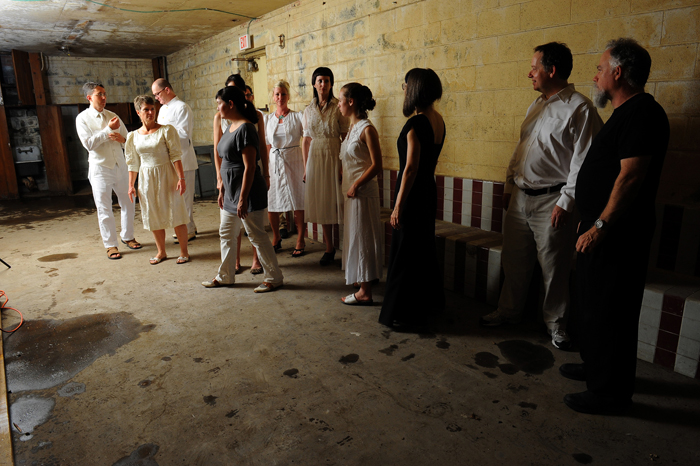

Logistics
In order to help participant-guests arrange themselves to fill in the desired "people screen" shape, I created an initial grid to be projected from the elevated camera onto the ground that looked like this:
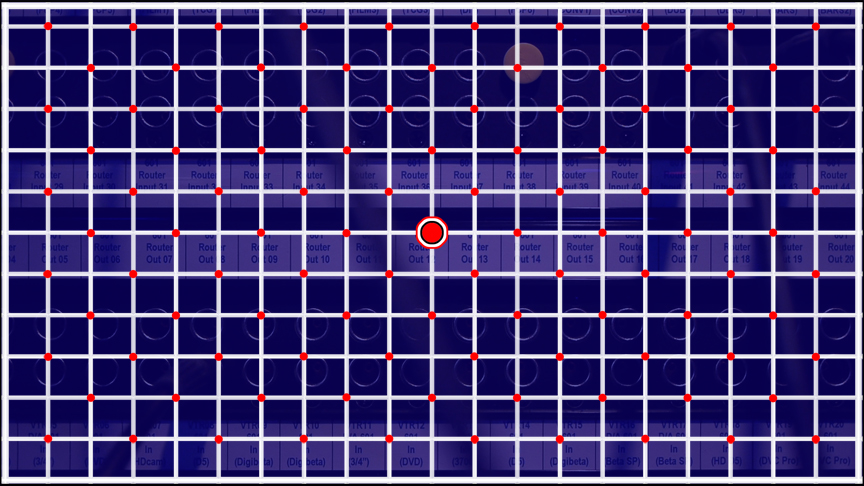
Or rather, that is roughly how the distribution of people was intended to look from the point of view of the elevated camera. When this grid is actually projected downward at an angle to the ground, it stretches and fans out (note: the actual layout differed from the sketch below, in that the video on Screen 1 was rear-projected):
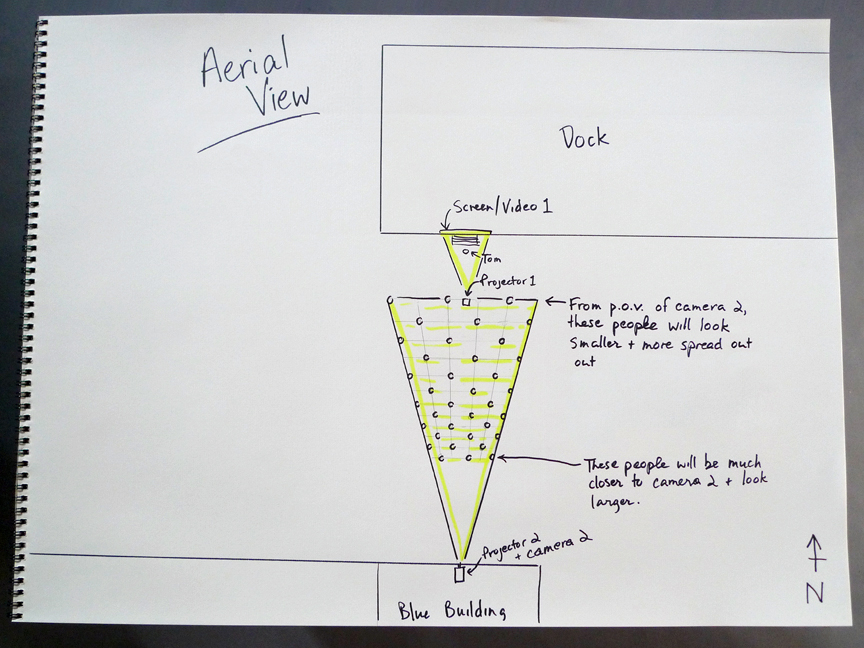
(A satellite view of the site and additional information can be found here. On-the-ground photos of the event location can be found here.)
As you can see, on the ground, the rectangle turns into a trapezoid or keystone shape; another effect is that the people farther from the elevated projector and camera are spread farther apart on the ground. These people also look smaller from that vantage point.
To compensate for this effect, the grid image actually projected at the event looked like this:
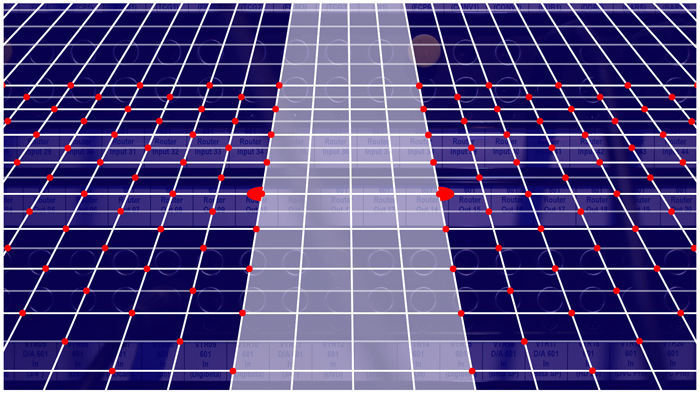
This grid was created using on-the-ground measurements during a trial run, to show how much the people farther from the elevated camera would need to be squinched together on the ground in order to give the appearance of relatively even distribution throughout the rectangular picture frame. (Note that it was not in fact necessary for people to stand on intersection points toward the very top of the projected grid, since the vertical height of the people standing in the last row that has red dots took up the top segment of the picture plane.)
This adjusted grid was projected during the first portion of the wedding/performance/screenings, as part of the Creation Ceremony video, onto a 4,000-square foot, keystone-shaped area of the parking lot that had been painted white in order to fill in the procession aisle and any gaps among the white-clad people. Looking downward from an aerial view at this grid image as actually projected and fanned out across the ground, the width of the aisle from beginning to end would be seen to be roughly constant.

Aesthetic Intentions
The following is meant to give an idea of some of the more straightforward or conscious concerns reflected in this project.
A perhaps over-arching subject for inquiry relates to issues involved in being an authentic, autonomous individual, within and as part of local and extended communities. The bond of a single, real marriage offers a metaphor and vehicle for exploring larger historical, sociological, psychological, epistemological, and metaphysical contexts – including the bond among all of humanity that now, by virtue of the internet, is becoming much more intense, or at least more thickly and quickly interconnected. Postulated is that both Individuals and groups small and large can be viewed as ecologies or partially-closed systems.
The imagery used in the videos, together with the projection structure and other aspects of the wedding/performance/screenings, were intended to invoke and explore issues relating to the destruction and re-creation of individual and collective identities; boundaries and connectedness; family and our expanding/contracting communities; time, history, memory, projection, and point of view; the interrelations among the first four and perhaps higher dimensions in real and virtual space; the intermixing of the highly-produced and the amateur, the "real" and the artificial; and the use of reality as an art medium, among other things – all within a context in which, for better and worse, p.r., performance, and the virtual or artificial seem to be overtaking – yet remain somehow subject to – the real.
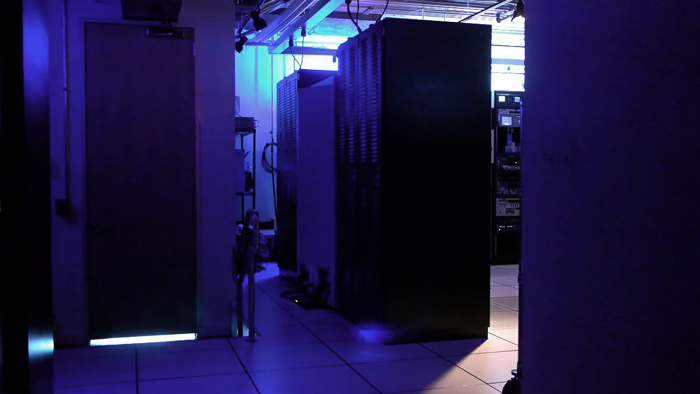
There have been many interesting art works in which the artist has transposed segments of their "real" lives into the context of a gallery or art institution in order to explore what happens when you put an "art" frame around what might otherwise look like ordinary life. I have attempted to complicate the matter by starting with a part of life that, although we think of it as "real," is in its very essence artificial – a marriage, like Tinkerbell, exists merely by virtue of our common consent to believe in it – and deploying it as a medium for an art work that (without any physical, institutional frame) proclaims itself as artifice.
One motif used in Wedding Ceremony for the relationship between real and artificial appears in the transformation of the Sosibios Vase into the drawing by John Keats – which itself was in turn transformed into his Ode on a Grecian Urn, arguably an even less real construct, yet one that mirrors the original not only to the extent of its literal description of the appearance of the vase and the real or imagined lives it depicts, but also in the symmetry and wholeness of the system of metaphorical relations within the poem and pointing outward from it. (To appropriate Shakespeare, good art "lies like truth" {Macbeth, V, v}.)
How do we distinguish between "real" and "artificial"? As technology continues to evolve, the difference is becoming more difficult to discern. It becomes increasingly interesting, and some might say important, to try understand whether and when the distinction matters, how we define it, and to hold ourselves responsible for the artifices that we project onto ourselves and others and into our shared worlds, for the projections we choose to believe in or rely on and the dreams we choose to pursue. (Perhaps the distinction is better understood as a multi-dimensional continuum; yet within given dimension(s), some artifices seem more consistently effectual than others?)
The project also responds to the fictionalization and commercialization of our deepest longings as a means of covertly influencing and exploiting us. Cash expenses for the wedding and wedding gifts were minimized as a matter of aesthetic principle as well as parsimony, and as mentioned, flowers and other items were hand-made or mustered from recycled or inexpensive, "inappropriate" materials.
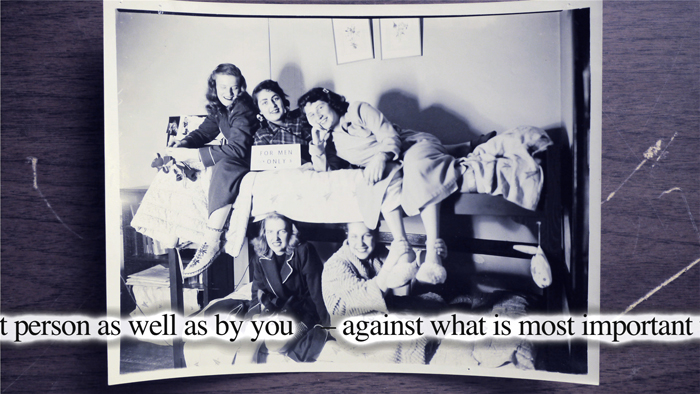
In a somewhat related vein, I personally am ambivalent about marriage, in light of, among other things, the curtailment of personal identity, freedom, and independence it has historically brought to women (see, e.g., Creamistress 6: "The Centered Polenta", or before that, the Brides photos). So I sought to subvert the prom queen-bride tradition – in which the day of the wedding is her "special day," a sort of consolation prize to the virgin for her sacrifices – and to avoid clichéd conventions connoting purity and perfection.
The approach of involving guests and other helpers as "brides," performers, and screen, together with the ceremony text and other aspects of the project, were intended among other things to both explore and strengthen the relationships among everyone involved in real and various virtual spaces, and also fit with a view of the bride as both projection and projected-upon.
The wedding ceremony text quotes the preamble to the U.S. Constitution, and I discovered after the event that, by sheer, happy accident, the wedding actually took place on the anniversary of the signing of that document. The project also reflects an awareness that many of the political systems we've tried seem either to boil down to "every man for himself," or else purport to sacrifice the well-being of the individual to that of the collective, and that neither of these "I or thou" approaches have proved livable over the long run. No marriage can work in which one is never willing to defer their own short-term gratification for the good of the other, OR in which the good of one is excessively subordinated to that of the other. The same holds true in relationships between or among larger groups. Perhaps what both marriage and larger communities call for is a sustained, continual effort by all to create and re-create systems in which the fundamental interests of all are aligned. But questions remain as to how those fundamental interests are defined, and whether and when longer-term benefits are or should be obtained through shorter-term conflicts of interests.
Governments and other systems are as much artifices of our own creation as are marriages. Ultimately, reality is an art medium (though often less wieldy than more traditional media); and our power to make and re-make the "real" as well as the virtual has never been greater. 2012 is the end of the world: the world is always ending, always already becoming something beyond itself; yet it's never too late for us to try to use our artistic powers – our knowledge, love, and creativity – to co-create it as we'd like it to be.
Among the influences or works I like and have had in mind are Peter Campus's Three Transitions (1973); Valie Export's Adjunct Dislocations II (1973-78) from pro music nova, Theater im Packhaus, Bremen, 1978; Time Smoking a Picture (1980) by Thierry Kuntzel et al.; Tacita Dean's Kodak (2006); Hobbit Love is the Greatest Love (2007) by Steve Reinke; Annie Lloyd (2008) by Cecilia Condit; David Gatten's Film for Invisible Ink, case no. 323: ONCE UPON A TIME IN THE WEST (2010); Jaclyn Pryor's participatory Pink (2006-7); works all or partially in virtual reality such as RMB City (2008-present) by Cao Fei and Second Life Dumpster (2007-8) by eteam (especially their 2008 "trash tower"); and as usual, Shakespeare (especially The Tempest) and Plato (especially the "allegory of the cave" from The Republic).
The ceremony text used in the Wedding Ceremony video can be found here.
|